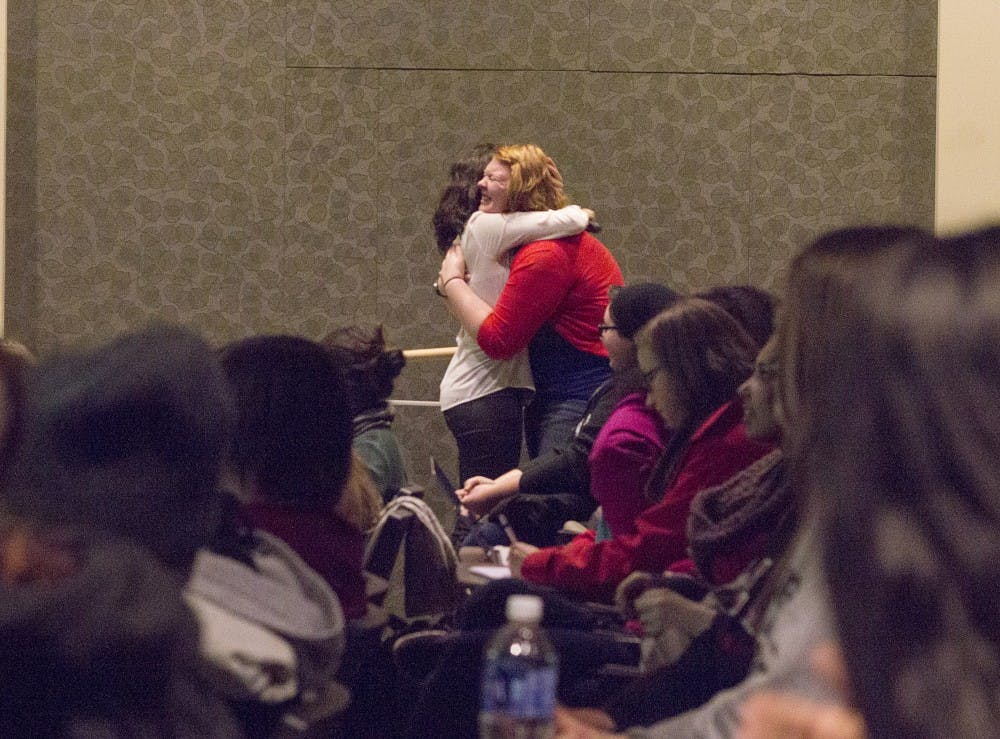Illustrator Carol Rossetti gained internet fame after her feminist art series "The Women Project" went viral last year. The Brazil-based graphic designer spoke in Art and Journalism Building 175 last night as part of the Women and Gender Studies' week-long celebration of women, "Sister, Cister!" Here, she answers some questions:
DN PHOTO EMMA ROGERS
DN:
What is your history with art and feminism?
CR:
I don’t actually have a history with that. [The Women Project] was my first work that I mixed art and activism. Before that I had only been learning about feminism. It wasn’t a concept that has always been clear for me. I started by listening; learning not speaking just getting to know what people was talking about. When I thought I was ready to make my own concepts I started doing this project.
DN:
How and when did the concept of feminism become clear to you?
CR:
It became clear about 4 years ago. I really had no idea what feminism was about. I only had contact with stereotypes and ideas that don’t really correspond to the truth. I came across a Brazilian blog that spoke about feminism in a soft way. It was speaking of it but it wasn’t angry, and it did not assume that everyone who read it knew what the concept of feminism was about. It was kind of teaching people and that was important to me. After that I began reading other things from all over the world. I learned about the different ways to be a feminist. Only then did things become clearer for me.
DN:
You spoke a lot about intersectional feminism during your presentation last night, why do you think it is so important?
CR:
I think that our old school feminists did a wonderful job considering what they had. I know that when something in the formation stages we do our best even though it might not be the best way. At first feminism was something European, American but very white. It was just for white women who were not necessarily rich but not poor. They had an education, so they were not talking for every woman; they were not representing them all. Today more than ever it is important, because images are very powerful. Where there is image there is a narrative. Representation of women is still very weak. We do not see as many women of color as we should. There is not a lot of representation considering sexuality and identity and gender. So now that our first feminist important things like the right to vote and work. It is time to improve things in this manner. It is time to care about things that were not mentioned for example transsexual women. Ten years ago they were pretty much invisible, they are still invisible. We have to bring visibility “if the fight does not include all women it is not efficient, I do not consider it a good fight. People need to feel safe inside feminism.”
DN:
Why is it important to represent all women in your work?
CR:
Everybody wants and deserves to be seen. This is something that I noticed about my work, people were glad, relieved, so happy that they were being seen.
DN:
How do you decide on what characters you draw?
CR:
All the characters are fictional. I get an idea for a theme or situation; I research by talking to people and reading about the situation. I try to learn about what people are thinking in this situation. When I think that it is relevant and people will identify with it, I write the text. The drawing of the character is random. I try to make a character different from the ones I’ve drawn before.
DN:
Do you think that issues of feminism in Brazil are different than those faced in America?
CR:
In a way there are many similar things, because a lot of feminist talks go on the Internet and everyone is together. But it’s a different culture, the politics is different the fight is different. There are something’s that are more okay in one place and not the other. For example I know that some states (in the US) have illegal abortion, in Brazil it is illegal in the whole country. Another example is racism. It is equally problematic in both countries, but because of how diverse Brazil is there is a myth that racism does not exist but it does.
DN:
Your work is based on everyone’s freedom to do what he or she wants. Do you find your self still judging people?
CR:
Yes, it happens. This project has helped me a lot I have learned so much and have gotten to know so many different people, cultures and realities. I once got an email from a pedophile that told me he is sick. He has never abused a child, he takes treatment but there is no cure. He has a mental illness in which his desire was misplaced. In Brazil we have this saying ‘pedophilia is a crime.’ But it is not a crime it is a disease, abusing children is a crime. At first I would judge him, I realized that I was judging him out of ignorance. You have to humble yourself and say ‘I don’t know everything’ recognize what you’ve been doing is wrong then commit to yourself not to do it anymore.
DN:
Where is the women’s project going from here?
CR:
I would like the book to be a full collection. I have made some new illustrations exclusively for the book. I think I will stop making new illustrations after this but it doesn’t mean that the women’s project is going to die, I will keep it alive and keep the conversation and my next project might have a feminist undertone





